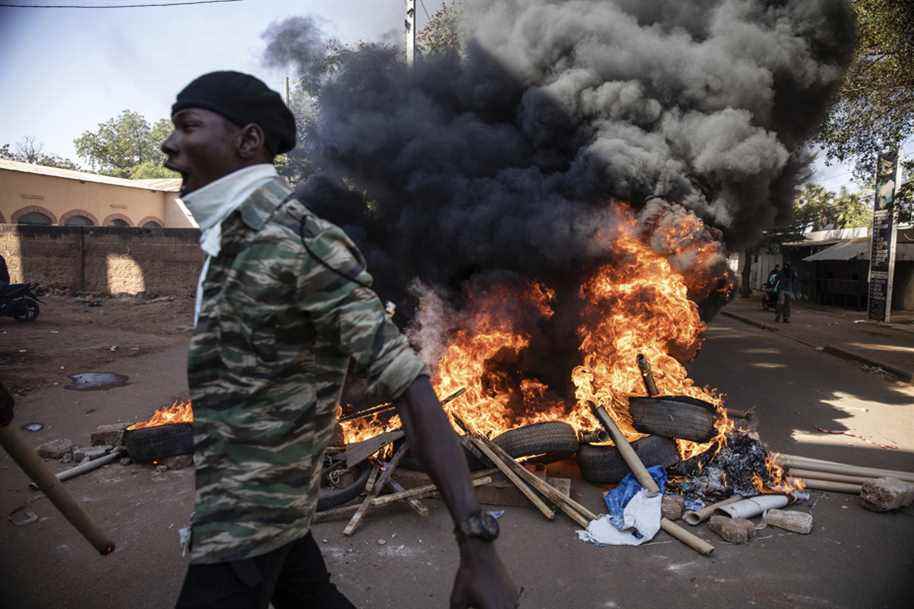(Ouagadougou) Several people, including a child and two journalists, were injured Saturday in the capital of Burkina Faso, Ouagadougou, in incidents that erupted after the dispersal of hundreds of demonstrators denouncing the “inability” of the power to counter jihadist violence ravaging the country.
In the morning, riot police fired tear gas to prevent demonstrators from gathering at Place de la Nation, in the center of the Burkinabè capital crisscrossed by an important security device, where all businesses were closed, noted a journalist. from AFP.
After this muscular dispersion, young people erected makeshift barricades and burned tires in several districts of the capital.
Protesters also vandalized part of the civil registry office, after trying to set fire to the Ouagadougou town hall building, the mayor of which had banned demonstrations.
During the violence, a child under the age of 10 was injured by tear gas fire and handed over by the demonstrators to a riot unit of the gendarmerie, AFP noted.
Two Burkinabè journalists were also injured in tear gas fire, their media, the private Omega radio station and the Filinfos online site announced, without the seriousness of their injuries being known.
A spokesperson for the “November 27 Coalition” who called for a demonstration, Hervé Ouattara, spoke of “a lot of wounded”, of which “two are in a coma”, which could not be confirmed from an independent source. .
In a statement on national television, Security Minister Maxime Koné said there had been “a number of wounded” among the security forces, but said he did not yet have a death toll in the areas. two camps.
“Force must remain with the law”, he affirmed, “and we will work so that those who supported or called for the march answer for their actions”.

PHOTO SOPHIE GARCIA, ASSOCIATED PRESS
” Barbarity ”
“We went out for a peaceful march, but the reaction of the police set fire to the powder, forcing us to erect barricades,” said one of the demonstrators. “We do not want to burn the country which is already at war, but in the face of barbarism, we will defend ourselves”.
Protesters also burned tires outside the headquarters of the ruling People’s Movement for Progress (MPP) party and attacked journalists, including one from AFP.
“I went to the MPP headquarters with a colleague following rumors saying that the headquarters had been burnt down by demonstrators, the crowd rushed over us, threw stones, they wanted to block our car, shouting ‘France, we does not want you ”, said Olympia de Maismont, photo and video collaborator of AFP in Burkina Faso. “We managed to escape, but it was down to the second.”
One of the demonstrators, Fabrice Sawadogo, 28, affirmed that “after seven years of incapacity in the face of the terrorist attacks which mourn us every day, it is time to demand the departure of the regime”. “We do not have to negotiate with an incompetent government which has to admit that it has failed,” he said.
Demonstrations also took place in other cities of Burkina, in particular in Bobo Dioulasso (west), the second in the country, where demonstrators were also dispersed with tear gas. This was also the case in Kaya, a hundred kilometers northeast of Ouagadougou.
Several arrests
The November 27 Coalition, bringing together three civil society organizations, called on “all Burkinabè to come out en masse” on Saturday “in a peaceful atmosphere, to denounce the growing insecurity and demand the departure of the Head of State” Roch Marc Christian Kaboré.

PHOTO ANNE MIMAULT, REUTERS
Several demonstrators were arrested, including one of the leaders of the “Movement Save Burkina Faso”, according to this organization member of the coalition, without giving the number of arrests.
Other civil society movements have called for standing out from these demonstrations, “not to be complicit with those who want to bring chaos to the country”.
Burkina Faso has been caught since 2015 in a spiral of violence attributed to jihadist armed groups, affiliated with Al-Qaeda and the Islamic State group.
Attacks targeting civilians and soldiers are increasingly frequent and the vast majority concentrated in the north and east of the country.
The attack on November 14 on a gendarmerie detachment in Inata (north), one of the deadliest against the security forces, deeply shocked: at least 57 people, including 53 gendarmes, were killed by armed jihadists .
“We must put an end to the unacceptable dysfunctions which undermine the morale of our fighting troops and hamper their effectiveness in the fight against armed terrorist groups,” President Kaboré declared Thursday evening, words often repeated which no longer convince in the country.
Sometimes mixed with intercommunal clashes, jihadist violence has killed around 2,000 people over the past six years and forced 1.4 million people to flee their homes.
